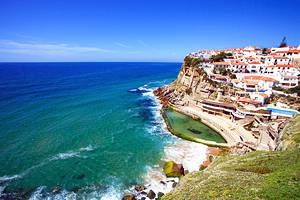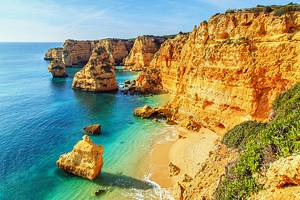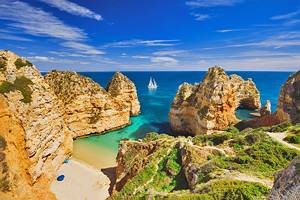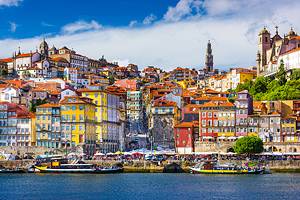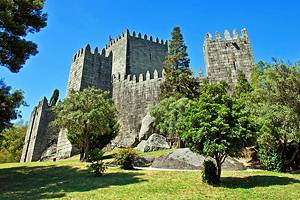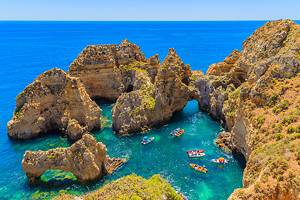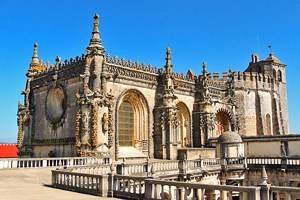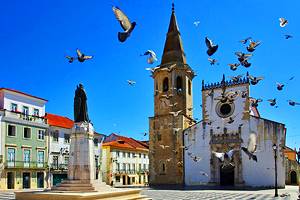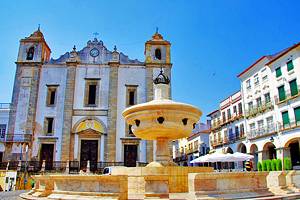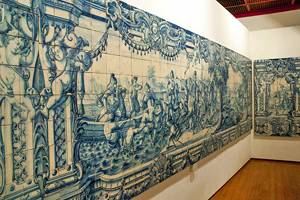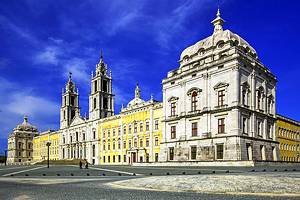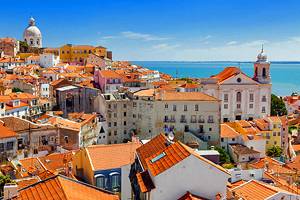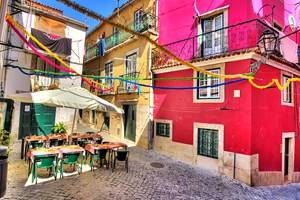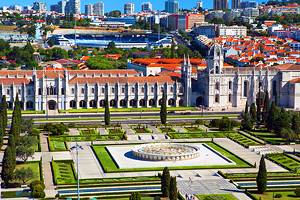Tourist Attractions in Portugal
Visiting Portugal is to discover a remarkably diverse destination. Inextricably linked with the sea, the country has more than 800 kilometers of enticing Atlantic Ocean coastline. Lisbon, the capital city, enjoys a stunning location near the mouth of the River Tagus. From here, trailblazing mariners set sail in the 15th and 16th centuries on epic voyages of discovery, and Portugal has nurtured a proud seafaring tradition ever since.
Portugal's interior melds dramatic northern mountain ranges with the vast rolling plains of the country's sun-baked central regions. In the south, some of the best beaches in Europe flank picturesque coves and warm, shallow waters. Dotted throughout are stone-built villages, enchanting towns, and cosmopolitan cities where historic palaces and castles, museums, and monasteries are waiting to be explored.
And traveling to Portugal can also mean a visit to the verdant, subtropical island of Madeira - the "Garden Isle" - or the isolated, but tranquil Azores archipelago. For more ideas on the best places to visit, see our list of the top tourist attractions in Portugal.
- Mosteiro dos Jerónimos, Lisbon
- Oceanário de Lisboa, Lisbon
- Palácio Nacional de Sintra, Lisbon Coast
- Kayaking the Lisbon Coast
- Torre de Belém, Lisbon
- Convento do Cristo, Tomar
- Bom Jesus do Monte, Braga
- Hiking the Gerês Mountain Range
- Universidade de Coimbra
- Museu Calouste Gulbenkian, Lisbon
- Castelo de Guimarães
- Torre de Clérigos, Oporto
- Castelo de São Jorge, Lisbon
- Sé (cathedral) and Roman Temple, Évora
- Mosteiro Pálacio Nacional de Mafra
- Igreja de Santo António and the Museu Municipal, Lagos
- Silves Castle
- Cross-Border Zipline, Alcoutim
- Palácio da Bolsa, Oporto
- Alcobaça
- Paiva Walkways (Passadiços do Paiva), Arouca
- Côa Valley Archaeological Park (Parque Arqueológico do Vale do Côa), Vila Nova de Foz Côa
- Alentejo by Horseback
- Cabo da Roca
- Other Must-See Highlights of Portugal
Mosteiro dos Jerónimos, Lisbon
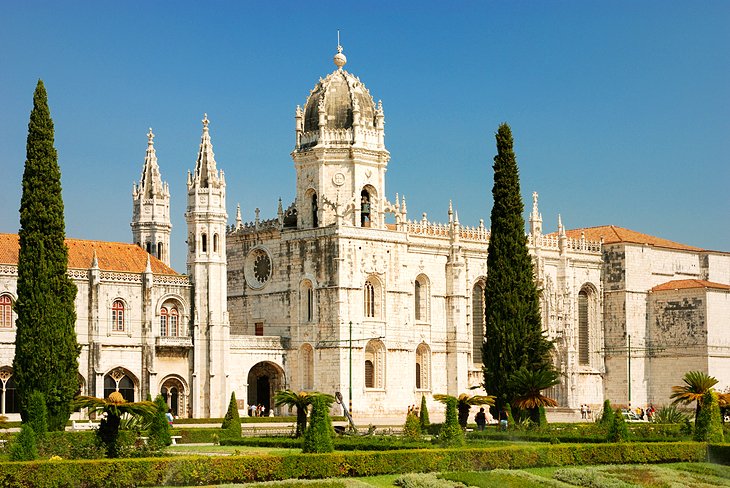
Belém is synonymous with Portugal's golden Age of Discovery. It's from the shores of this Lisbon suburb that intrepid navigators set sail in the 15th and 16th centuries on long and perilous voyages to chart unknown waters and map new territories.
One such mariner, Vasco da Gama, discovered the sea route to India in 1498, and to honor his achievement, King Manuel I commissioned a monument that became a lasting symbol of the country's astonishing era of conquest and expansion. Today, the Mosteiro dos Jerónimos is one of the country's most cherished and revered buildings, and is a must-see on every tourist's agenda.
The church and monastery embody the spirit of the age, and feature some of the finest examples of Manueline architecture found anywhere in Portugal; the beautifully embellished decoration found on the South Portal is breathtaking.
Inside, the beautiful cloister is equally exuberant. Appropriately, the church houses the tomb of Vasco da Gama and other national figureheads, including Luís de Camões, Portugal's greatest poet and chronicler of the discoveries.
Oceanário de Lisboa, Lisbon
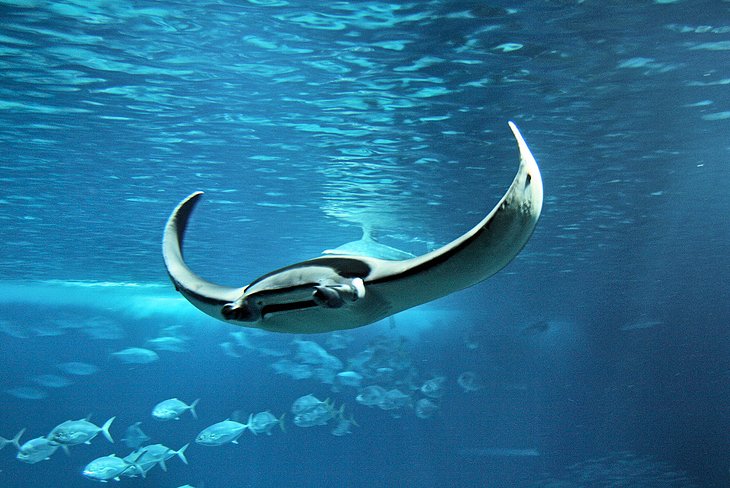
Arguably Portugal's most popular and family-friendly visitor attraction, Lisbon's oceanarium is brilliantly conceived to highlight the world's diverse ocean habitats. This is one of Europe's best and largest oceanariums, containing a vast array of fish and marine animals.
Four separate sea- and landscapes recreate the ecosystems of the Atlantic, Pacific, Indian, and Antarctic oceans. A huge central tank, visible from different levels, teems with shark, ray, and many other finned wonders and denizens of the deep. The transparent plexiglass design is such that smaller tropical species housed in separate aquaria set around the main tank appear to be swimming with their larger cousins.
Complementing this amazing spectacle are the open-air landscapes, where penguins, sea otters, and other cute and cuddly birds and mammals co-exist in carefree harmony.
- Read More:
- Tourist Attractions in Lisbon
Palácio Nacional de Sintra, Lisbon Coast
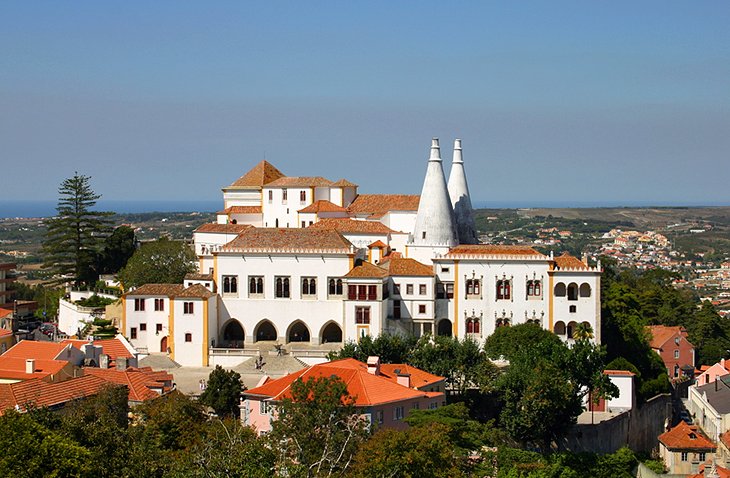
Nestling in the lap of a wooded mountain range, Sintra's stunning location is reason enough to visit this charming, verdant town. Indeed, UNESCO acknowledges the destination as a World Heritage cultural landscape such is its beauty and the significance of the collection of historic visitor attractions clustered in and around the old town, Sintra Velha.
A favorite summer retreat for the kings and queens of Portugal and an alluring destination for numerous writers and poets, including Lord Byron and William Beckford, Sintra exudes romance. The old town is a maze of cobbled lanes lined with handsome town houses painted in pastel hues of pink, mustard, and lilac. The narrow streets surround a pretty central square that's dominated by the wonderful Palácio Nacional de Sintra.
Easily recognized by its huge conical chimneys, Sintra's National Palace dates from the late 14th century and is the oldest surviving palace in Portugal. Regally furnished, the building is set over several floors, many conveying a unique theme and decorated accordingly. A highlight is the magnificent Sala dos Brasões, a glittering domed hall embellished with the coats of arms of 72 noble Portuguese families.
Kayaking the Lisbon Coast
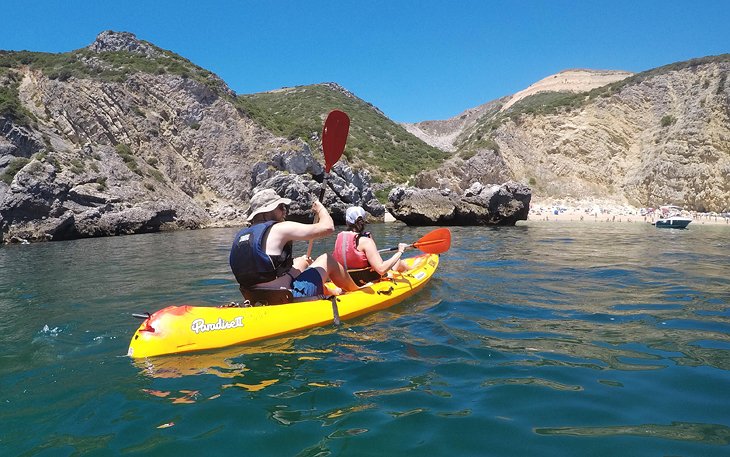
Taking to the sea by kayak to explore the Lisbon coast makes for a rewarding maritime excursion. Besides offering an extra dimension to the sightseeing experience, paddling the coastline provides an excellent excuse to exercise in a salt-laced, pristine environment.
Indeed, Lisbon's proximity to the ocean allows for a wide range of exciting water sports, and discovering the beaches, bays, and coves set along the region between the Portuguese capital and the resort town of Cascais is a fun-packed way to enjoy a day out.
Beyond the area, the crystal-clear waters off the Serra da Arrábida Natural Park, which encompass places like Setubal and Sesimbra, comprise a unique landscape of magnificent, ancient sea cliffs that teem with birdlife.
Most of the coastline here lies within a protected marine reserve - a sanctuary that includes within its boundaries the wonderfully picturesque Ribeira do Cavalo beach.
Torre de Belém, Lisbon
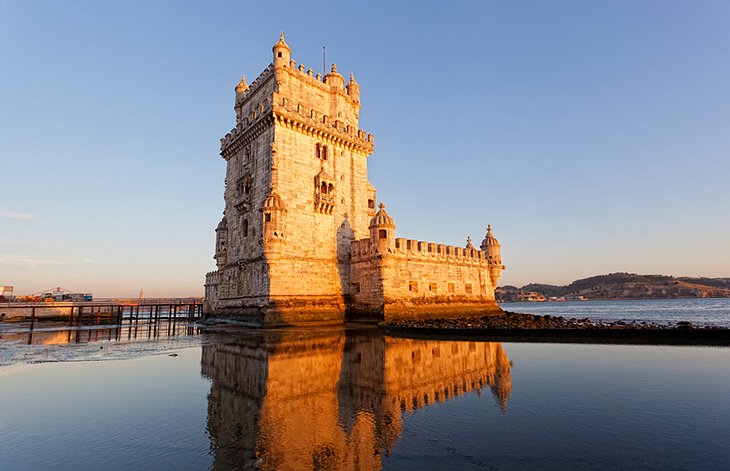
One of Portugal's best-loved historic monuments and a Lisbon icon, the Torre de Belém stands as a symbol of the Age of Discovery and the voyages of exploration undertaken in the 15th and 16th centuries.
Completed in 1521 as a fortress to defend the approaches to the River Tagus, the tower is regarded as a masterpiece of military architecture. Designed in the Manueline style by Francisco de Arruda, the façade is a confection of beautifully carved stone, typified by maritime motifs, such as twisted rope and the armillary sphere. An impressive Renaissance loggia heightens the decoration.
The tower's cultural significance is such that UNESCO has listed it as a World Heritage Site.
- Read More: Visiting Torre de Belém: Attractions
Convento do Cristo, Tomar
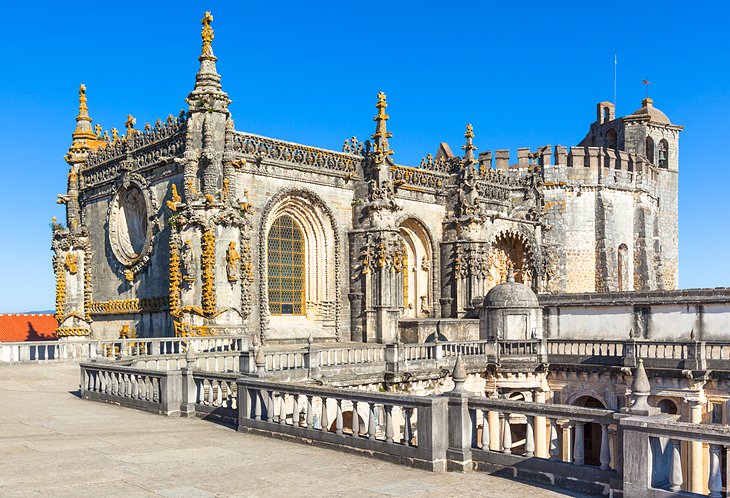
Dominating the charming riverside town of Tomar is a mighty castle that shields the Convento do Cristo, one of Portugal's standout historic attractions.
Founded in 1160 as the headquarters of the Order of the Knights Templar, the Convent of Christ is as awe-inspiring as it is mysterious, its masonic heritage tangible and beguiling. At its center is the medieval Charola, the original Templar church, richly decorated and exuding all the strange symbolism associated with the Order of Christ.
The 16th-century cloisters bewitch with Manueline flourishes and tease visitors with their concealed spiral staircases. And the convent's magnificent Manueline window, designed by master sculptor Diogo de Arruda, remains one of the most architecturally appealing aspects of any building found in Portugal.
Bom Jesus do Monte, Braga

Bom Jesus do Monte, Portugal's grandest religious sanctuary, is located on a wooded slope six kilometers east of Braga and is one of the most important pilgrimage sites in the country.
Comprising a monumental Baroque Escadaria (stairway) and the church of Bom Jesus, this spectacular complex also features several chapels adorned with sculptured scenes from the Passion of Christ; fountains positioned at various points on the long ascent; and statues of biblical, mythological, and symbolic figures.
Climbing the lower section of the 116-meter-long ornamental granite staircase is to slowly zig-zag past a steep Sacred Way, with chapels showing the 14 Stations of the Cross.
Midway, the white, interleaved Escadório dos Cinco Sentidos depicts the five senses by way of finely carved statuary.
The final section is the Staircase of the Three Virtues, representing Faith, Hope, and Charity, that leads to the church. Your efforts will be rewarded with an inspiring panorama of the surrounding countryside. For the less active, a vintage 1882 funicular whisks visitors to the top in just three minutes.
Hiking the Gerês Mountain Range
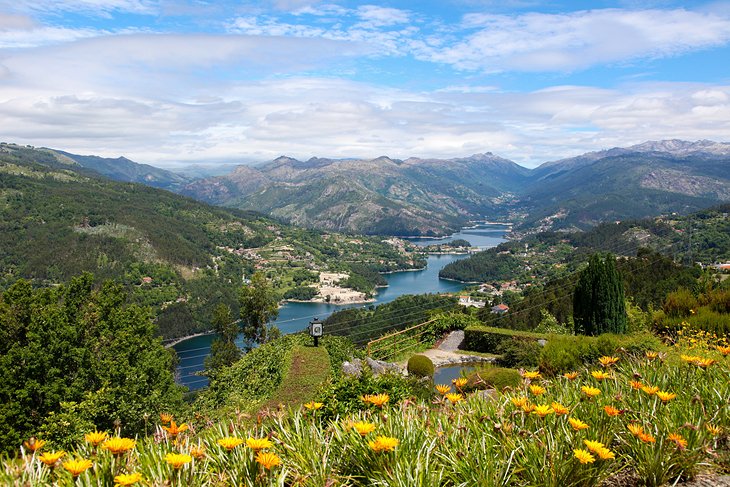
The Serra do Gerês is a mountain range of breathtaking beauty found in northern Portugal's remote Minho region. Set within the glorious Parque Nacional da Peneda-Gerês, one of the top places to visit in Portugal, the granite peaks that define the character of this vast national park number among the highest and most spectacular in the country.
As one of Portugal's greatest natural attractions, the Gerês Mountains draw walkers, hikers, and lovers of the outdoors to one of Europe's last great wildernesses, a stark and rugged landscape noted for its lush valleys dotted with shimmering lakes, a scattering of traditional villages, rare flora and fauna, and a way of life that has all but disappeared from the rest of the country's mountain regions.
The area is crisscrossed by ancient granite trails, which are signposted for hikers to follow, either as a short stroll or a challenging day trek. Most of the tracks are 10 to 16 kilometers in length and of varying grades.
Universidade de Coimbra

The Universidade de Coimbra is Portugal's oldest seat of learning, founded in 1290 by King Dinis. Acknowledged by UNESCO as a World Heritage Site, the historic buildings of the Velha Universidade, or old Coimbra University, surround a beautiful colonnaded central square, the Paço das Escolas.
The Alta and Sofia wings of the university - a former royal residence - reward visitors with a number of star features, including the astonishing Biblioteca Joanina, a sumptuously decorated library installed in 1717 by King João V.
A tour also takes in the dazzlingly ornate 16th-century Capela de São Miguel. Those with a head for heights can climb the landmark 18th-century clock tower for a grand perspective over Coimbra, one of the country's most attractive cities.
Museu Calouste Gulbenkian, Lisbon
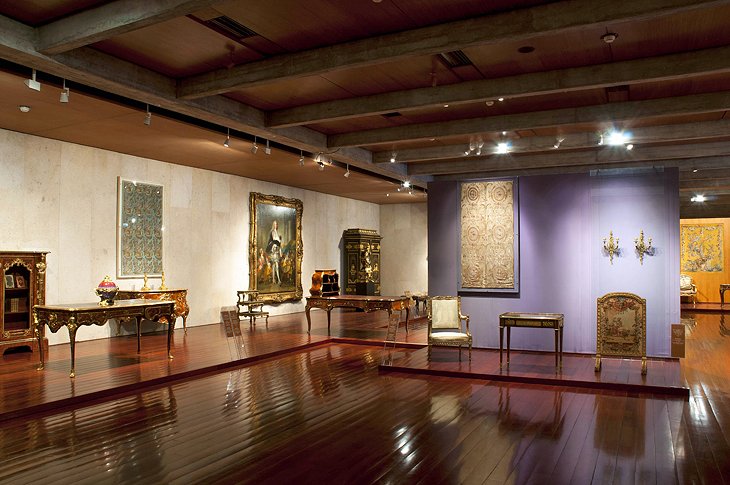
Lisbon is blessed with some truly world-class museums, and one of the finest is the Museu Calouste Gulbenkian. The museum's collection numbers some 6,000 pieces, all of which belonged to just one man: Calouste Sarkis Gulbenkian, a wealthy Armenian oil magnate who bequeathed his priceless hoard to the Portuguese nation upon his death in 1955.
Quite simply, this is one of the finest collections of art in Europe. The exhibits span more than 4,000 years from classical and oriental Antiquity to European art of the early 20th century. No other museum has such varied pieces of art from so many places in the world, and visitors can spend hours mulling over treasures such as the 11 Roman medallions found in Egypt; 16th-century illustrated manuscripts; masterpieces by Rubens, Rembrandt, and Turner; Louis XV and Louis XVI furniture; and Art Nouveau jewelry made by Rene Lalique.
The museum lies in beautiful lush gardens that are perfect for picnics, especially during the summer months.
Castelo de Guimarães
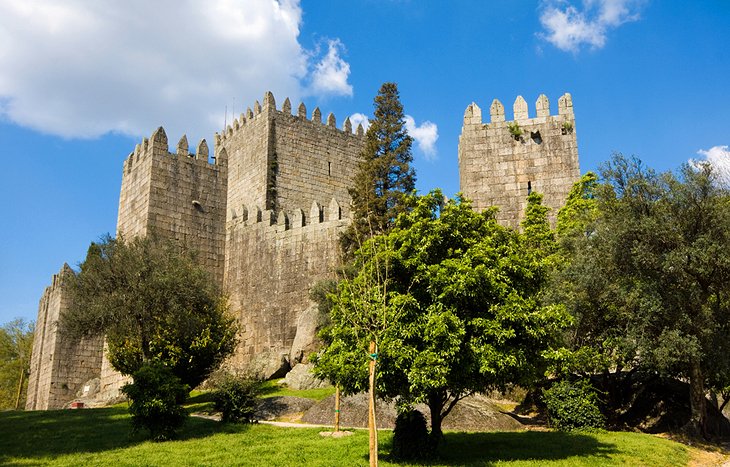
The birthplace of the nation and where Portugal's first monarch, Dom Afonso Henriques, was born in 1110, Guimarães was once the capital of the kingdom of "Portucale."
Recognized by UNESCO as a World Heritage Site for its collection of historic monuments grouped in and around the old town center, it is the Castelo de Guimarães that best symbolizes the role played by the town in defining the nation's culture and tradition - it even appears on the Portuguese coat of arms.
Originally built in the 10th century, but substantially extended by Henry of Burgundy two centuries later, the stronghold, on an elevated outcrop of granite, comprises a central keep - the Torre de Menagem - surrounded by massive battlements and fortified towers.
Dom Afonso was baptized in the tiny Romanesque chapel of São Miguel, located just outside the castle walls, and visitors can peek inside the diminutive space to see the font. A walk along the ramparts is inspiring, but for the best views, climb the keep.
- Read More:
- Tourist Attractions in Guimarães
Torre de Clérigos, Oporto

The spindly, needle-like Torre de Clérigos is one of Oporto's defining landmarks. Standing 75 meters above the streets and overlooking the old town, this slender tower was built in the 18th century by Nicolau Nasoni and exudes a bold sense of the Baroque. Designed as part of the Igreja dos Clérigos, the tower was completed in 1763 and at the time was the tallest building in Oporto.
To reach the top, visitors need to climb upwards of 200 steps, but the huffing and puffing will all be forgotten as you embrace truly magnificent views of the city and the River Douro.
Castelo de São Jorge, Lisbon
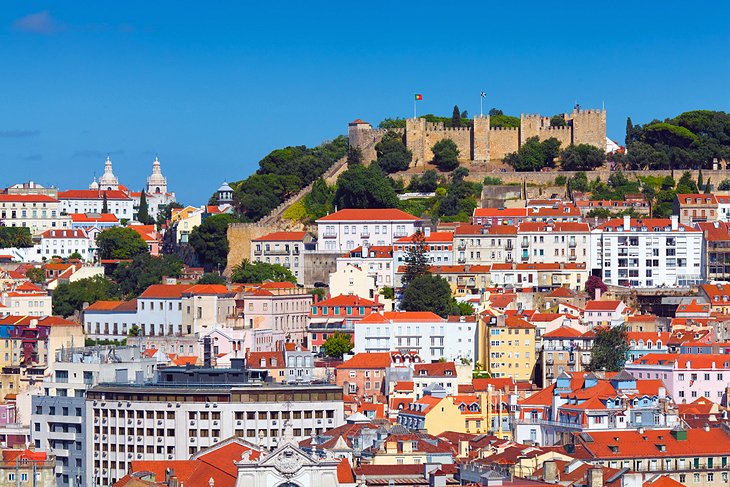
Its commanding position crowning a hill and overlooking Lisbon's bustling Baixa (downtown) district defines Castelo de São Jorge as the city's most visible historic monument. Hugely popular with locals and tourists alike, the foundations of this impressive castle date from the late 12th century when King Afonso Henriques recaptured the city from the Moors and built a palace over the ruins of their hilltop citadel.
In 1511, the royal residence was extended and reinforced with sturdy battlements. The great earthquake of 1755 leveled much of the structure, and what remains today is largely the result of substantial renovation.
Exploring the castle is great fun. Visitors can walk the ramparts and the castellated towers, one of which, Torre de Ulisses, has a camera obscura that projects views of the city onto the inside walls. The walls enclose an archaeological site with the remains of the original Alcáçova palace and ancient Moorish foundations.
The observation terrace near the entrance affords the most spectacular views across Lisbon and the river.
Sé (cathedral) and Roman Temple, Évora
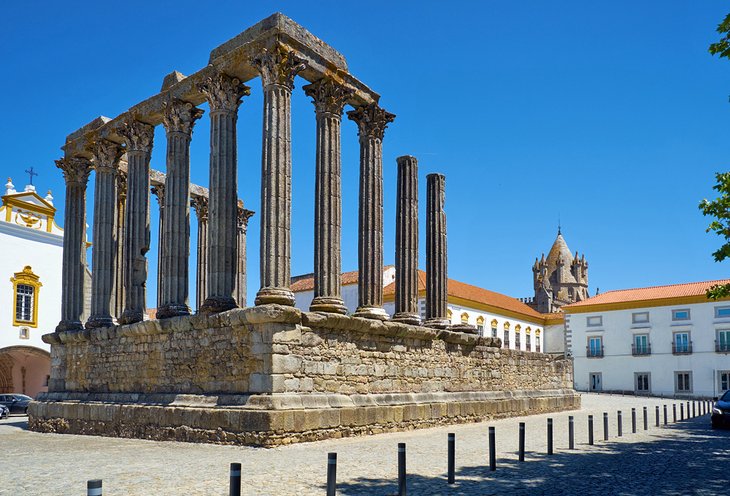
Set deep in southern Portugal's sun baked Alentejo province is Évora, one of the country's most enchanting cities. The Romans established themselves here in 57 BC, but it was under Moorish rule that the town began to take shape, its maze of narrow lanes and alleys typical of Islamic urban design. Christian reconquest saw the construction of the Sé, Évora's impressive cathedral and one of several stunning visitor attractions in the old town.
Consecrated in 1204, this celebrated religious building melds the Romanesque with the Gothic and the Baroque, and after admiring the interior, visitors can nip up to the roof, which offers fantastic views over the vicinity.
Nearby is Évora's most iconic monument, the Roman Temple. Erected in the 2nd or 3rd century AD, this is the most impressive Roman building in the country. In fact, Évora's historic legacy is such that UNESCO has declared the destination a World Heritage Site.
Mosteiro Pálacio Nacional de Mafra

The majestic National Palace and Monastery of Mafra looms over the pleasant countryside town of Mafra and represents an outstanding example of grandiose excess.
Work began in 1717 on what was originally supposed to be a simple monastery and basilica, commissioned by Dom João V to honor the birth of the king's first child. But as wealth from Brazil swelled the royal coffers, the project took on a new dimension and eventually, a huge Baroque palace was built, lavishly decorated with exotic furnishings and numerous works of art.
A tour allows access to the monastery, palace, church, and basilica. One of the undoubted highlights of the National Palace and Monastery of Mafra is the sumptuous marble floored library, where more than 40,000 rare and precious books line Rococo-style wooden bookcases - one of the most important collections of manuscripts and literature in Europe.
Igreja de Santo António and the Museu Municipal, Lagos
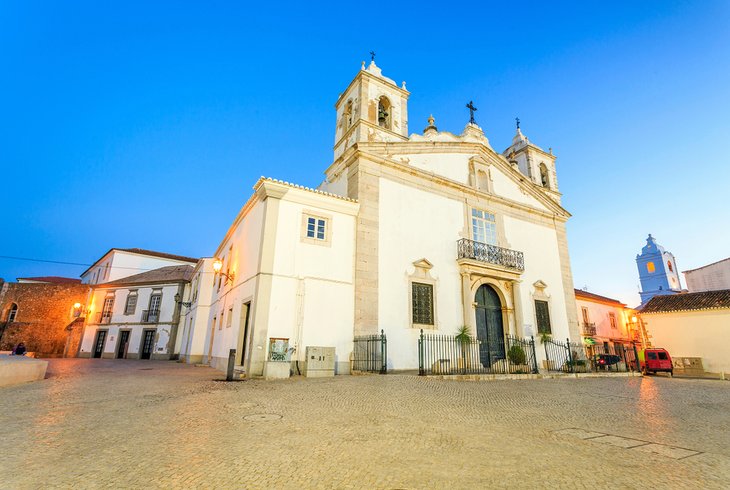
The Municipal Museum in Lagos holds the quirkiest collection of archeology and ethnography in the Algarve. The wonderfully eclectic display of local handicrafts, curios, and artifacts perfectly illustrates the region's diverse culture and heritage and includes items like an altarpiece handcrafted from cork and a realistic homemade scale model of an imaginary Algarve village.
A highlight is the impressive Opus Vermiculatum Roman Mosaic, unearthed in 1933 by the museum's founder, Dr José Formosinho. Tours conclude with a visit to the Igreja de Santo António and a dazzling interior of ornate gilded carvings and decorative azulejos panels.
- Read More:
- Tourist Attractions in Lagos
Silves Castle

As Xelb, Silves was once the capital city of Moorish Algarve, and the Arabs named the region al-Gharb.
During the early 12th century, the town was renowned as a center of learning, a place where Islamic writers, philosophers, and geographers gathered. To protect the inhabitants, the Moors built a mighty castle on an elevated position overlooking the town.
Captured later by Crusaders, the fortress stands today as a permanent reminder of Moorish domination and Christian Reconquest. It is the most impressive historic monument in the Algarve and one of the top castles in Portugal. Its huge walls of red sandstone color the pleasant riverside town of Silves below with an inviting ochre glow.
Visit during early August and revel in the annual Medieval Festival set outside the sturdy battlements.
Cross-Border Zipline, Alcoutim
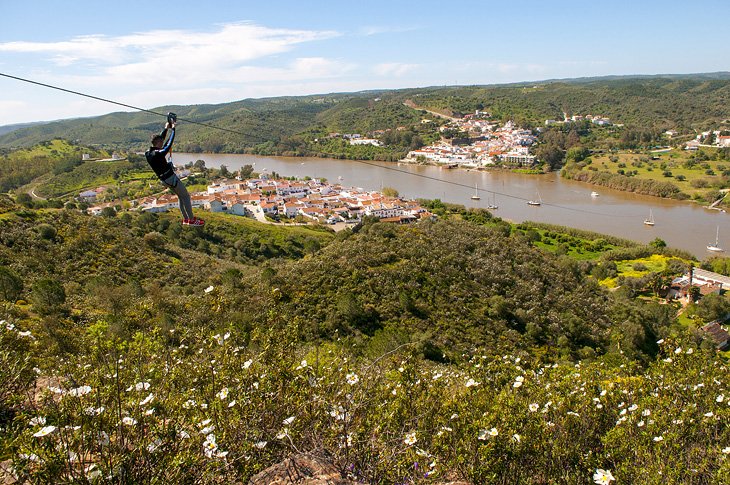
Spanning Spain and Portugal and currently the world's only cross-border zipline, this is one of the most daring and radical tourist attractions in the country. Connecting Sanlúcar de Guadiana in Spain's Huelva province with Alcoutim in the far north of the Algarve, the line measures 720 meters and joins the two countries across the wide and meandering River Guadiana.
Participants, fully kitted out in safety harnesses and helmets, begin their flight from a departure platform set high above the river overlooking the sleepy hamlet of Sanlúcar. Crossing the river at speeds of between 70 and 80 kilometers per hour, they literally fly through time, gaining one hour because of the time difference between the two countries.
Thrilling and wholly original, the ride offers a totally different Algarve visitor experience, and it's not everyday you can boast of traveling from one country to another in under one minute!
Palácio da Bolsa, Oporto
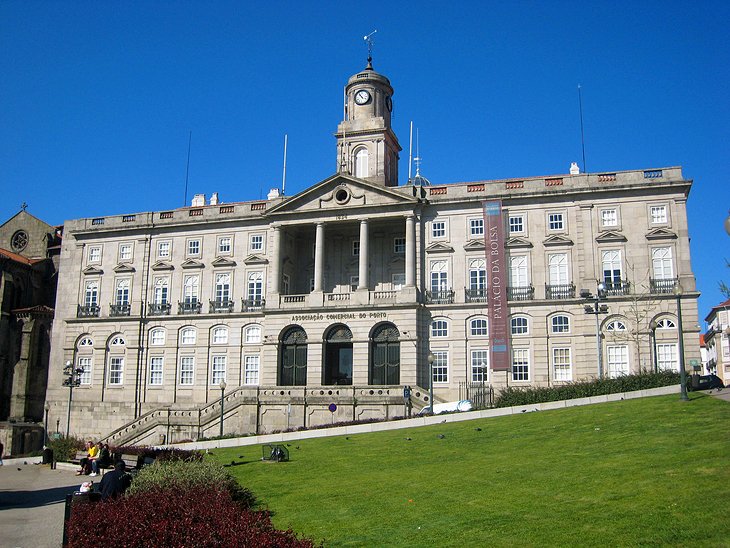
Oporto's alluring medley of visitor attractions includes the city's former stock exchange building, the beautiful Palácio da Bolsa. Built by merchants in the mid-19th-century on a site where the monastery of São Francisco once stood, the palace lies within the old city boundaries and as such enjoys UNESCO World Heritage status.
The dazzling interior reflects the wealth pouring into the city at that time, and a tour of the ornate rooms and galleries reveals a grandness and richness as extravagant as any royal palace. Epitomizing this opulence is the incredible Salão Árabe, the Arabian Room. Inspired by the Alhambra in Granada, the magnificently gilded salon is wrapped in blue and gold Moorish-style decoration that shimmers like Aladdin's cave.
Alcobaça
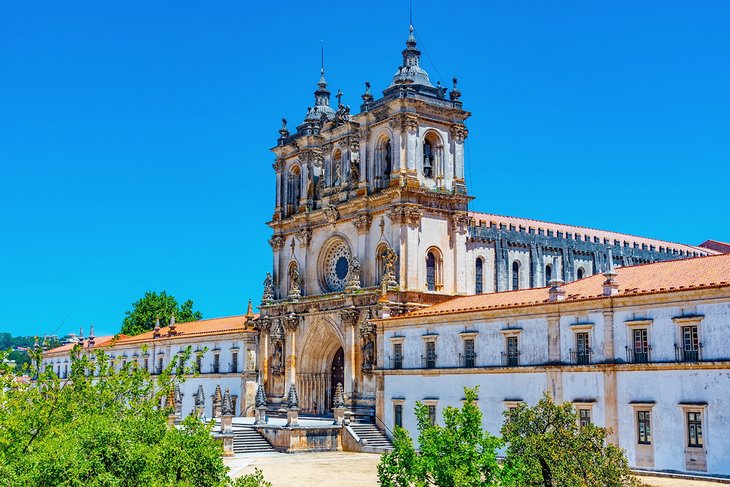
Portugal's central area is home to one of the country's hidden gems, Alcobaça. It's a quaint, small place off the main tourist track, allowing you to fully immerse yourself in the remarkable Old Town. Spend time wandering the winding streets full of cafes, restaurants, art galleries, and shops.
The town is in the heart of Portugal's agricultural region and is renowned for Pêra Rocha' pears and apples which feature prominently in the local gastronomy.
A highlight of a visit, though, is the Monastery of Alcobaça. This UNESCO World Heritage site is a shining example of Gothic, Baroque, and Manueline architectural styles. It's a quiet and contemplative place that has survived from the 12th Century until today. The Monastery is Portugal's largest church and is especially noted for having one of the largest medieval Cistercian cloisters in Europe; the Claustro do Silencio.
Paiva Walkways (Passadiços do Paiva), Arouca
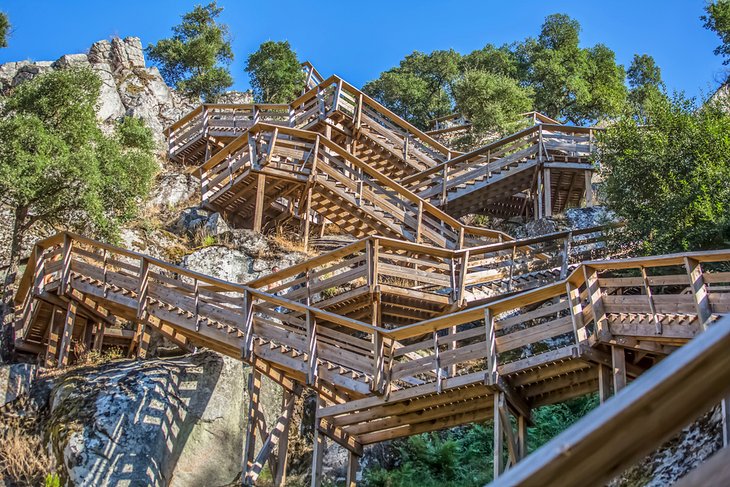
Translated as the Paiva Walkways, this award-winning facility ticks all the green boxes. Located outside the town of Arouca, a 70-kilometer drive north of Aveiro in central Portugal, the Paiva Walkways provide a challenging but highly rewarding eight-kilometer hike over an elevated boardwalk that dips, climbs, and meanders through the Arouca Geopark - an unspoiled landscape of outstanding beauty, and a biodiversity hot spot.
The walk commences at Areinho and partway follows the pristine River Paiva downstream. Very soon, you're hiking through a rugged, seldom-seen environment of peaceful, verdant woodland and deep, yawning gorges.
Along the way, you pass tumbling waterfalls and serene, mirror-like pools. Quite often the trek involves negotiating long flights of zigzagging steps over steep inclines: the route really does test stamina and physical fitness.
The walk takes around 2.5 hours to complete, ending in Espiunca. Remember to pack sunscreen, energy snacks, and plenty of water.
Côa Valley Archaeological Park (Parque Arqueológico do Vale do Côa), Vila Nova de Foz Côa

In the early 1990s, a team of engineers surveying a valley of the River Côa, in northeastern Portugal, while planning the construction of a dam discovered thousands of rock drawings from prehistoric times etched into giant slabs of granite. It was a rare and outstanding find.
The dam project was subsequently canceled, and the engravings - featuring horses, cattle, weapons, and human and abstract figures, the earliest of which date back 22,000 years BCE - were eventually designated a UNESCO World Heritage Site.
Today, visitors can admire this ancient rock art preserved in situ at the Côa Valley Archaeological Park by joining a guided tour in all-terrain vehicles. They can also find out more about the history behind the origins of the artwork and explore the valley through multimedia, photography, and images of the engravings at the fabulous Côa Museum, located at the gateway to the park.
Alentejo by Horseback

Whether following a narrow, gurgling stream; traversing a flower-flecked meadow; or plodding over a soft, sandy track, one of the great things to do in the Alentejo is to explore the region on horseback.
The province is known for its love affair with horses - the beautiful and mild-mannered Lusitano breed is synonymous with this part of Portugal, especially in towns like Alter do Chão, home to the Coudelaria de Alter stud.
Leisurely rides can be enjoyed in the countryside or along the coast, led by expert guides who were practically born in the saddle. Comporta is a favorite seaside destination; inland, head for places like Alcácer do Sal, on the River Sado, and Ourique, located deep in the forested hinterland.
Cabo da Roca
Cabo da Roca is most notable for being the westernmost point in Europe. Dramatic cliffs descend into the crashing waves of the Atlantic Ocean and unsurpassed views extend to the horizon. A historic lighthouse stands as a sturdy sentinel on this wind-blasted rugged point of land, a welcoming beacon for wandering mariners.
Search out the plaque and read the famous words of Luís de Camões, who like many who lived in the 14th Century, truly believed that this was the edge of the world "where the land ends and the sea begins."
Other Must-See Highlights of Portugal

Exploring Southern Portugal: Portugal's fine beaches offer pleasant year-round diversion and, in the Algarve especially, are sited near some fabulous holiday resorts. In fact, southern Portugal is also known for its standout destinations, such as the regional capital Faro, plus Tavira and Portimão. Remember, too, that Portugal's islands offer a totally different travel experience. Learn more about Funchal in Madeira and Ponta Delgada in the Azores.


